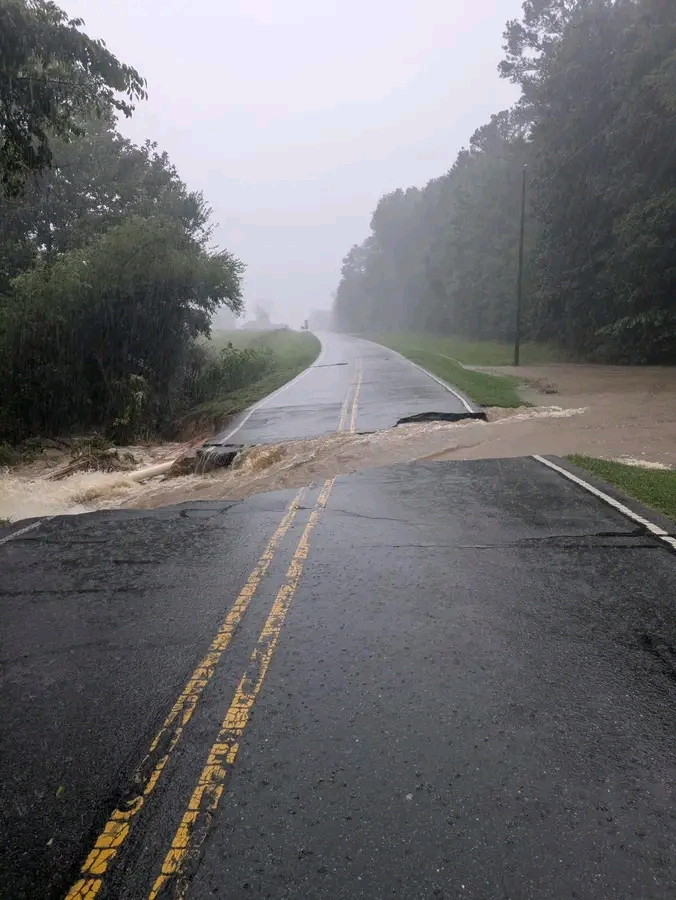Severe Flooding Crisis Shuts Down Critical Roads Across Chatham County, NC, as NC Highway 902 Collapses Near Chatham Central Road
CHATHAM COUNTY, NC — A growing and increasingly dangerous flooding emergency has engulfed parts of Chatham County and surrounding regions, leaving behind a trail of devastation, road closures, and widespread concern for public safety. Emergency officials are issuing urgent warnings for all residents to avoid unnecessary travel and remain indoors as conditions worsen.
Among the most significant and alarming developments in this weather-driven disaster is the full collapse and closure of NC Highway 902 near Chatham Central Road, a vital artery for local traffic that is now completely impassable due to extensive flood damage. The roadbed itself gave way under the weight of torrential rain, surging water, and underlying erosion, marking one of the most dramatic consequences of the ongoing weather event.
A Region Brought to a Standstill
The collapse of NC Highway 902 has not only severed a crucial transportation link but has also symbolized the overwhelming force and danger of the storm system that has descended upon Central North Carolina. More than 100 roads across the broader region have been affected, with closures ranging from minor blockages due to standing water to complete structural failures of bridges and overpasses.
Residents across the region are grappling with the reality of being cut off from essential services, workplaces, schools, and even nearby family members. For rural communities in particular, where access to resources often depends on a handful of roads, the closures have added layers of urgency and complexity to emergency response efforts.
NC Highway 902 Collapse: What We Know
The collapse occurred early Sunday following hours of relentless rainfall, which meteorologists say dumped between six and ten inches of water across the county in less than 24 hours. While the road had experienced minor flooding in previous weather events, officials noted that nothing of this scale had been recorded in recent years.
Photos and video from the scene show the pavement sheared away, revealing twisted rebar and crumbled concrete beneath where the road once ran smoothly. In some areas, entire sections of roadway appear to have been washed away, leaving jagged edges and rushing floodwaters surging beneath.
County engineers and Department of Transportation (DOT) officials are currently assessing the full scope of the damage, but preliminary reports suggest that rebuilding the highway could take weeks—possibly months—depending on weather patterns and resource availability.
First Responders Work Around the Clock
Despite the increasingly hazardous conditions, first responders have been working tirelessly to evacuate residents from flooded homes, clear debris, and direct traffic away from danger zones. Emergency shelters have been set up throughout the county, with schools, churches, and community centers being transformed into safe havens for those displaced by rising waters.
Swift-water rescue teams have been deployed from nearby counties, and the National Guard has been placed on standby as conditions continue to evolve. So far, officials have confirmed dozens of water rescues, particularly in low-lying areas near creeks, ponds, and tributaries that overflowed their banks.
“It’s a massive effort,” said one emergency services official. “We’re coordinating on every level—state, county, municipal—to ensure residents are safe, but we need the public to take these warnings seriously. Stay off the roads, avoid flooded areas, and check in on your neighbors.”
The Emotional Toll on Communities
Beyond the physical damage and logistical chaos, the emotional toll of the flooding has begun to settle in. Families have watched helplessly as water crept into their homes, damaging treasured possessions and lifelong memories. Small businesses, many still recovering from prior economic challenges, now face new setbacks as storefronts are inundated or rendered inaccessible.
Parents worry for their children’s safety, especially as power outages have left some areas without communication or access to critical information. Elderly residents, many of whom depend on daily care or transportation services, are particularly vulnerable during such emergencies.
“I’ve lived here for over 40 years,” said one resident from a nearby town. “We’ve had bad storms, sure. But this… this is something else entirely. You don’t expect the roads to just disappear beneath your feet.”
Environmental Concerns and Long-Term Implications
Environmental experts are also sounding alarms over the ecological damage caused by the floods. Overflowing sewage systems, chemical runoff from industrial sites, and soil erosion all pose long-term risks to the region’s water quality and wildlife. Streams and rivers choked with debris could lead to habitat loss for aquatic life, while standing water becomes a breeding ground for mosquitoes and waterborne diseases.
Agricultural communities are facing uncertain futures as crops are submerged and livestock stranded. Many farmers are now weighing whether to attempt salvage operations or cut their losses entirely—decisions that could affect food supplies and local economies well beyond county lines.
Road Infrastructure Under Review
In response to the collapse of NC Highway 902 and other reported damage across the region, state transportation officials have announced a full review of regional infrastructure. Aging roadways, insufficient drainage systems, and climate-related stress have created vulnerabilities in many parts of rural and semi-urban North Carolina.
Transportation experts emphasize that investment in resilient infrastructure will be necessary going forward. This includes reinforcing bridges, elevating flood-prone roadways, and expanding drainage networks capable of managing extreme rainfall.
“These kinds of flood events are becoming more frequent and more intense,” a DOT engineer noted. “What we considered a hundred-year storm is now happening every decade—or even more often. We need to build accordingly.”
Calls for State and Federal Assistance
Local leaders are now pressing for both state and federal disaster declarations to unlock emergency funds, grant programs, and logistical support. Applications are being submitted to FEMA and the Governor’s Office, with damage assessments expected to follow swiftly once floodwaters recede.
Elected officials from Chatham County and nearby regions are urging constituents to document all damage, including photos of affected homes, roads, vehicles, and businesses. These records will be vital in processing insurance claims and recovery grants.
Several nonprofit organizations have already mobilized to provide relief, collecting supplies such as bottled water, non-perishable food, diapers, blankets, and hygiene products for displaced families. Donations are being accepted both online and at designated drop-off locations.
Community Resilience in the Face of Disaster
Amid the devastation, countless acts of bravery, generosity, and community spirit have emerged. Neighbors helping neighbors. Volunteers guiding families through waist-deep water. Local churches opening their doors without hesitation.
In one striking image captured by a rescue worker, a group of volunteers can be seen forming a human chain to help an elderly couple exit their flooded vehicle. Moments like these reflect the enduring spirit of Chatham County—a region where hardship is met not with resignation, but with solidarity and action.
“It’s what we do,” said one volunteer. “When things get hard, we show up for each other. That’s what being part of this community means.”
Looking Ahead: Recovery and Rebuilding
As the rains subside and floodwaters slowly recede, the process of recovery will begin. For some, this will mean returning home and beginning the long, painful task of cleaning up. For others, the damage may be too severe, and relocation could be the only option.
Officials are encouraging residents to exercise caution during the early stages of cleanup. Contaminated water, unstable structures, and downed power lines present serious dangers. Safety teams will begin inspecting homes and buildings as soon as conditions allow.
Despite the hardship, many residents remain hopeful. Community leaders are already developing recovery plans that include road reconstruction, mental health resources, and long-term resilience initiatives aimed at better preparing for future disasters.
Final Thoughts
The collapse of NC Highway 902 near Chatham Central Road is more than a transportation disruption—it is a sobering symbol of how fragile our systems become in the face of nature’s power. Yet, in every closed road, every flooded home, and every uncertain moment, the unwavering strength of the Chatham County community shines through.
With courage, cooperation, and compassion, residents are navigating this crisis together—determined not just to rebuild, but to rise stronger than before.




